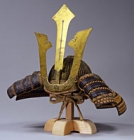Japanese Gallery (Honkan) Room 14
March 29, 2005 (Tue) - July 3, 2005 (Sun)
Helmets to protect heads were made in various shapes and styles since the Kofun period. A helmet consists of a bowl and shikoro (the part protecting the neck). Both ends of shikoro are curved backward, which are called fukikaeshi (blown back).
Helmets of the Heian period (794-1185) are considered to have been developed from the beaked helmets. The bowl was made of five to a dozen triangular metal plates joined together with conical rivets called hoshi (star). At its top was a hole to let the hair knot out. In the Muromachi period, (1392-1573), flat head rivets were used for the bowl, and the seams were conspicuously raised, resulting in the change of the name of the bowl from hoshi style bowl to suji (lobed) style bowl. From the Azuchi-Momoyama to the Edo period, tosei kabuto (modern helmets) were made by covering plain bowls with various shapes like mountain, animal, sea creature and other objects made of lacquered paper or some other light materials, or have various decorations such as hair or large crests in diverse forms. In the late Edo period, classical helmets modeled after medieval examples were made. Models of traditional helmets made today as decoration of the Boy's Festival on May 5th are based on these medieval revival designs.

